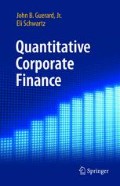Abstract
Long-term debt is the term given to those obligations the firm does not have to pay for at least a year. They are also called funded debt or fixed liabilities. Items that may be classed as long-term debt are bonds, debentures, term loans, or, in small firms, mortgages on buildings. The portion of the long-term debt due within the current year is carried in the current liability section of the balance sheet. Firms in the US issue far more debt than equity shares.
Access this chapter
Tax calculation will be finalised at checkout
Purchases are for personal use only
Preview
Unable to display preview. Download preview PDF.
References
Bierman, H., 1972. “The Bond Refunding Decision.” Financial Management, 22-29.
Bradley, I. F., 1959. Fundamentals of Corporation Finance. rev. ed., Halt, Rinehart and Winston, Ch. 17.
Brealey, R.A. and S.C. Myers. 2003. Principles of Corporate Finance. McGraw-Hill/Irwin, 7th Edition, Chapter 26.
Fisher, L. 1959. “Determinants of Risk Premiums on Corporate Bonds,” Journal of Political Economy 47, 217-237.
Gerstenberg, C. W., 1959. Financial Organization and Management of Business. 4th ed., Prentice-Hall, Ch. 8.
Hicks, J.R. 1937. Value and Capital. London: Oxford University Press.
Macaulay, F.R. 1938. Some Theoretical Problems Suggested by the Movements of Interest Rates. New York: Columbia University Press.
Malkiel, B.G., 1962. “Expectations, Bond Prices, and the Term Structure of Interest Rates.” Quarterly Journal of Economics 76, 197-218.
Malkiel, B.G., 1962. “The Term Structure of Interest Rates.” American Economic Review54, 532-543.
Myers, S., 1977. “Determinants of Corporate Borrowing.” Journal of Financial Economics5, 147-176.
Schwartz, E., 1962. Corporate Finance. St. Martin’s Press. Chapter 9.
Schwartz, E. 1967. “The Refunding Decision”. Journal of Business 40, 448-449.
Van Horne, J.C. 2002. Financial Management & Policy, Prentice Hall, 12th edition,Chapter 18.
Van Horne, J.C. 2002. Financial Market Rates and Flows. New York: Prentice-Hall, Inc., 6th edition.
Author information
Authors and Affiliations
Rights and permissions
Copyright information
© 2007 Springer Science+Business Media, LLC
About this chapter
Cite this chapter
Guerard, J.B., Schwartz, E. (2007). Long-Term Debt. In: Quantitative Corporate Finance. Springer, Boston, MA. https://doi.org/10.1007/978-0-387-34465-2_9
Download citation
DOI: https://doi.org/10.1007/978-0-387-34465-2_9
Publisher Name: Springer, Boston, MA
Print ISBN: 978-1-4020-7019-8
Online ISBN: 978-0-387-34465-2
eBook Packages: Business and EconomicsBusiness and Management (R0)

